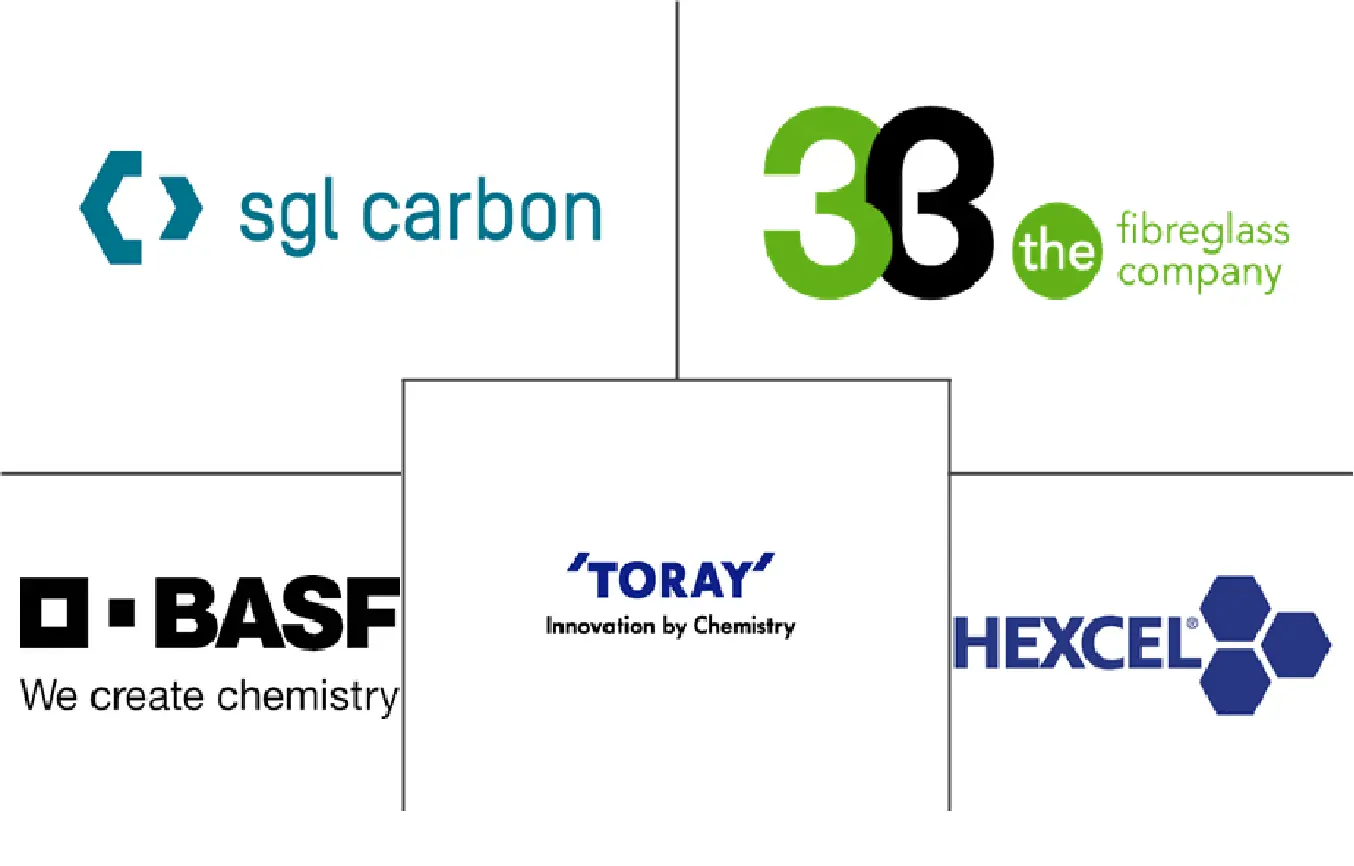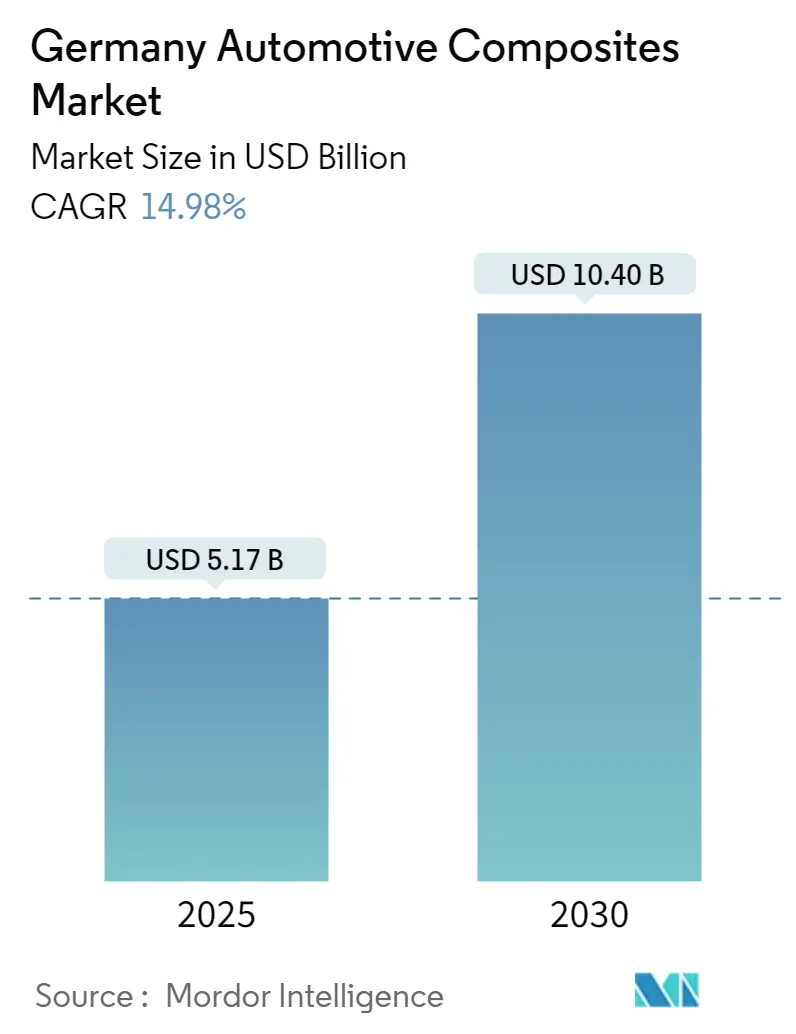
Germany Automotive Composites Market Analysis by Mordor Intelligence
The Germany Automotive Composites Market size is estimated at USD 5.17 billion in 2025, and is expected to reach USD 10.40 billion by 2030, at a CAGR of 14.98% during the forecast period (2025-2030).
- The COVID-19 pandemic had a significant impact on the German automotive composites market. The market was already facing challenges due to rising raw material prices and increasing competition from other materials. However, the pandemic exacerbated these challenges and led to a decline in demand for automotive composites. But as the situation gets normalized, the market has gained its stable position.
- To meet the emissions regulations and policies, OEMs are trying to reduce the weight of automobiles by employing lightweight composites. Composites have been adapted as the primary strategy. High-speed production, accuracy, stability, strength-to-weight ratio, better finish, and simple assembly are some of the many reasons to employ composite materials. However, high costs associated with carbon fiber composites and glass fiber composites are hindering the growth of the market, as their usage in low-cost vehicles could drastically increase the prices of such vehicles. OEMs are investing in R&D to develop inexpensive methods to make the composites available to a wide range of customers.
- Presently, composite materials, like thermoplastics and reinforced glass, have drawn the attention of carmakers, making them focus on sourcing better, tensile, and lighter components in the manufacture of automobile units.
Germany Automotive Composites Market Trends and Insights
Increasing Application of Lightweight Materials
- With sufficient technological advancements, German manufacturers are expected to see a rise in demand for car exports, which, the intern will increase demand for composite materials as manufacturers are looking to reduce car weight to keep up with emission norms across the world.
- With the introduction of electric automobiles in the market, the growth rate is expected to grow during the forecasted period. As Germany is racing towards reducing energy usage, the automotive composites market will have a positive impact. The automotive industry has been focusing on vehicle weight for decades, as vehicle weight has a direct effect on driving dynamics and fuel consumption.
- Due to the high cost of potential lightweight solutions and consumers' limited willingness to pay for weight reduction in automotive, the use of costly lightweight materials has so far been limited. As governments from around the world are implementing stringent emission regulations and even are planning to set even higher emissions standards in the coming years, the importance of lightweight materials will increase. In a typical automobile, the use of fibers is 50% by volume while adding just 10% to the weight. As per the US Department of Energy (DOE), reducing the weight of vehicles by 10% yields an increase of 6-8% in fuel economy. As a result, companies have started using materials like carbon fiber and glass fiber composites to make vehicles lightweight and fuel-efficient. The usage of glass fiber composites aids in reducing vehicles by 25%. EU emission regulations mandate a mere 95 g/Km of CO2 from 2021, with another 15% reduction by 2025 and 2030 a further 30% reduction by 2021.
- According to European directives and standards (2000/53/EC-End Life 0f Vehicles), the US Department of Transportation, the automotive manufacturing industry has to follow certain norms regarding environmentally friendly recycling and dismantling of vehicles, higher fuel efficiency standards, and increase in the use of recyclable materials which offers high potential for the composites market to grow during the forecasted period. A slowdown in global economic growth and structural change in the automotive industry are hurting this market, but during the forecasted period, the composites market is expected to grow.
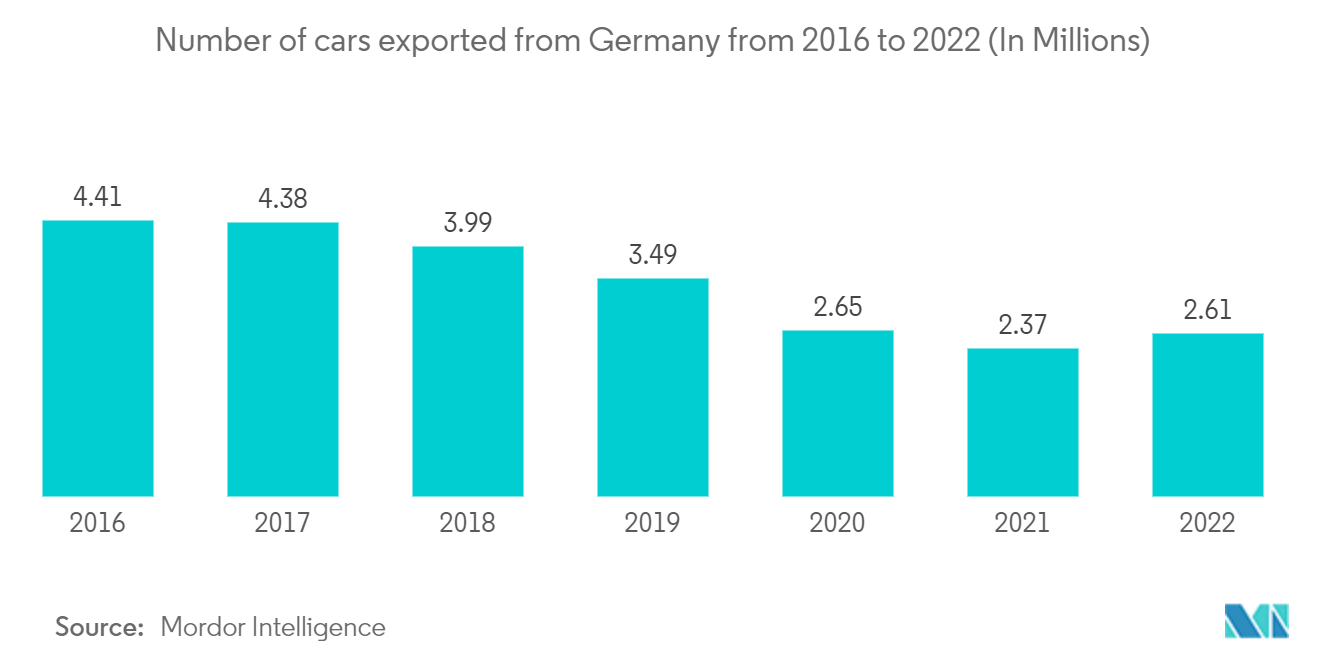
Technological Advancements To Drive the Market
- Technological advancements play a crucial role in driving the German automotive composites market forward. These advancements have led to the development of innovative materials, manufacturing processes, and applications that offer improved performance, cost-effectiveness, and sustainability. Here are some key technological advancements contributing to the growth of the German automotive composites market:
- The development of new composite materials with enhanced properties has been a significant driving force. For instance, carbon fiber reinforced composites offer exceptional strength-to-weight ratio, stiffness, and corrosion resistance. These materials are being increasingly used in the automotive industry to reduce the weight of vehicles, improve fuel efficiency, and enhance overall performance.
- For instance, in March 2023, BMW announced that it would be using carbon fiber composites in the production of its new iX electric vehicle. This is a significant move, as it is the first time that BMW has used carbon fiber composites in a mass-produced vehicle.
- Hybrid composites, which combine different types of reinforcing fibers or combine fibers with other materials, have gained traction. By combining the benefits of different materials, hybrid composites offer improved mechanical properties and tailor-made solutions for specific applications. This technology allows manufacturers to optimize weight reduction, increase strength, and achieve cost savings.
- Advanced manufacturing processes such as automated fiber placement (AFP) and automated tape laying (ATL) have revolutionized the production of composite components. These processes enable precise fiber placement and reduce human error, resulting in higher production efficiency, improved part quality, and reduced manufacturing costs. The use of robotics and computer-controlled systems in composite manufacturing has significantly accelerated the production rate and expanded the application of composites in the automotive sector.
- Computer-aided design (CAD) and simulation tools have become increasingly sophisticated, enabling engineers to model and analyze composite structures accurately. These tools aid in optimizing component design, predicting performance, and simulating manufacturing processes. The ability to simulate and predict behavior allows for efficient product development and reduces the need for costly physical prototypes.
- The focus on sustainability has driven the development of eco-friendly composites and manufacturing processes. Recycled carbon fibers, bio-based resins, and natural fibers are being used to create composites with reduced environmental impact. Furthermore, advancements in recycling technologies have made it possible to recover and reuse composite materials, reducing waste and improving the overall sustainability of the automotive industry.
- Overall, these technological advancements are driving the adoption of automotive composites in Germany. They offer significant benefits such as weight reduction, improved performance, energy efficiency, and sustainability, making composites an attractive choice for automotive manufacturers striving to meet the evolving demands of the market.
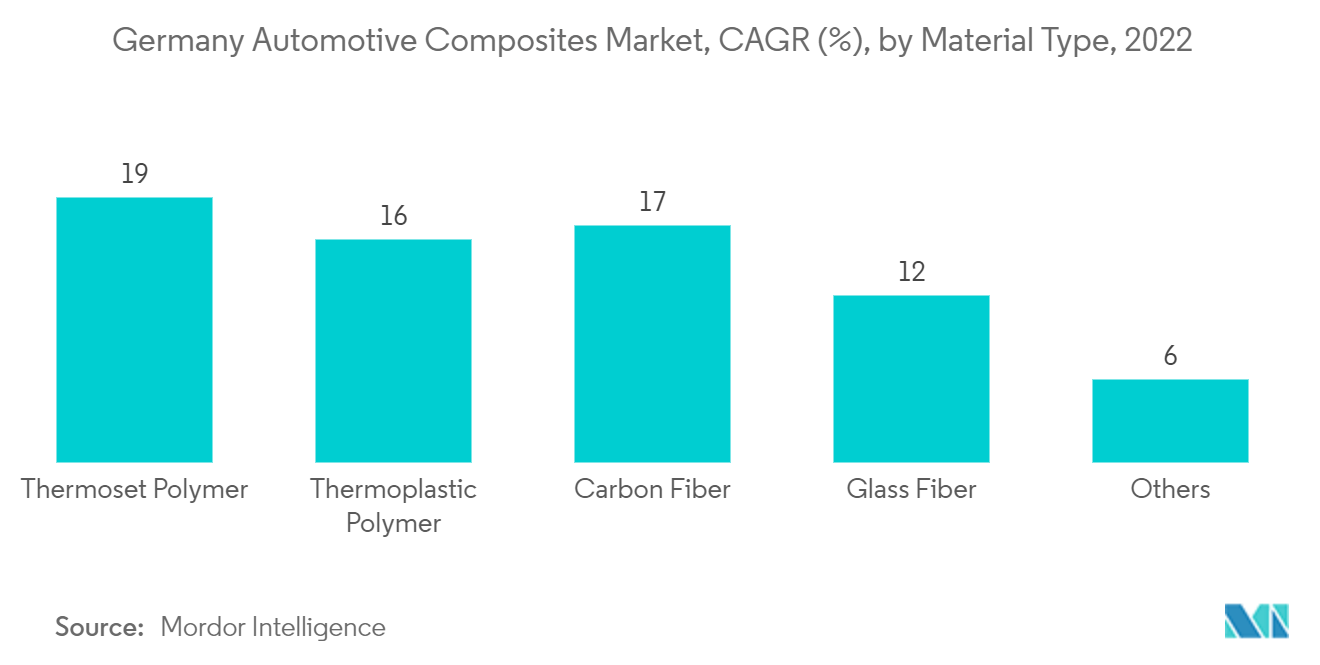
Competitive Landscape
The German automotive composites market is consolidated. Industry participants are expected to expect intensive competition owing to aggressive strategies, including acquisitions, pricing, mergers, and new product development. Significant players in the market are Hexcel Corporation, 3B Fiberglass, SGL Carbon, and Toray Industries Inc, BASF. Companies are trying to invent new composites that can reduce the total weight of the vehicle to much lower proportions.
Germany Automotive Composites Industry Leaders
Toray Group
SGL Carbon
Hexcel Corporation
3B Fiberglass
BASF
- *Disclaimer: Major Players sorted in no particular order
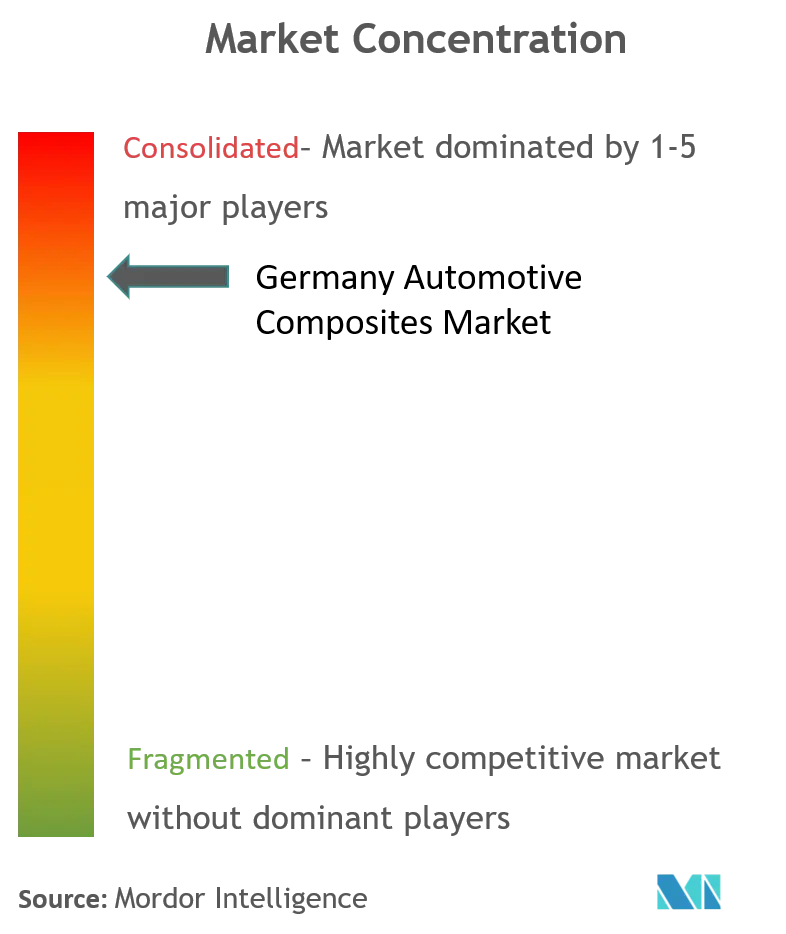
Recent Industry Developments
- April 2023: SGL Carbon announced that it would be investing EURO 100 million in a new plant in Germany to produce carbon fiber composites for the automotive industry. This investment is a sign of the growing demand for automotive composites in the Germany market.
- May 2023: BASF announced that it had developed a new type of glass fiber composite that is lighter and stronger than traditional glass fiber composites. This new composite is expected to be used in a variety of automotive applications, including body panels and engine components.
Germany Automotive Composites Market Report Scope
Automotive composites refer to materials used in the construction of vehicles that are composed of two or more distinct components. These composites are designed to provide a combination of desirable properties such as strength, lightweight, durability, and corrosion resistance, making them well-suited for use in the automotive industry.
The German automotive composites market is segmented by production type, material type, and by application type. By production type, the market is segmented into hand layup, resin transfer molding, vacuum infusion procession, injection molding, and compression molding. By material type, the market is segmented into thermoset polymer, thermoplastic polymer, carbon fiber, glass fiber, and other material types. By application type, the market is segmented into structural assembly, power train components, interior, exterior, and other applications.
The market sizing has been done in value terms in USD for all the abovementioned segments.
| Hand Layup |
| Resin Transfer Molding |
| Vacuum Infusion Processing |
| Injection Molding |
| Compression Molding |
| Thermoset Polymer |
| Thermoplastic Polymer |
| Carbon Fiber |
| Glass Fiber |
| Other Material Types |
| Structural Assembly |
| Power train Component |
| Interior |
| Exterior |
| Other Applications |
| By Production Type | Hand Layup |
| Resin Transfer Molding | |
| Vacuum Infusion Processing | |
| Injection Molding | |
| Compression Molding | |
| By Material Type | Thermoset Polymer |
| Thermoplastic Polymer | |
| Carbon Fiber | |
| Glass Fiber | |
| Other Material Types | |
| By Application | Structural Assembly |
| Power train Component | |
| Interior | |
| Exterior | |
| Other Applications |
Key Questions Answered in the Report
How big is the Germany Automotive Composites Market?
The Germany Automotive Composites Market size is expected to reach USD 5.17 billion in 2025 and grow at a CAGR of 14.98% to reach USD 10.40 billion by 2030.
What is the current Germany Automotive Composites Market size?
In 2025, the Germany Automotive Composites Market size is expected to reach USD 5.17 billion.
Who are the key players in Germany Automotive Composites Market?
Toray Group, SGL Carbon, Hexcel Corporation, 3B Fiberglass and BASF are the major companies operating in the Germany Automotive Composites Market.
What years does this Germany Automotive Composites Market cover, and what was the market size in 2024?
In 2024, the Germany Automotive Composites Market size was estimated at USD 4.40 billion. The report covers the Germany Automotive Composites Market historical market size for years: 2019, 2020, 2021, 2022, 2023 and 2024. The report also forecasts the Germany Automotive Composites Market size for years: 2025, 2026, 2027, 2028, 2029 and 2030.
Page last updated on:
Germany Automotive Composites Market Report
Statistics for the 2025 Germany Automotive Composites market share, size and revenue growth rate, created by Mordor Intelligence™ Industry Reports. Germany Automotive Composites analysis includes a market forecast outlook for 2025 to 2030 and historical overview. Get a sample of this industry analysis as a free report PDF download.
